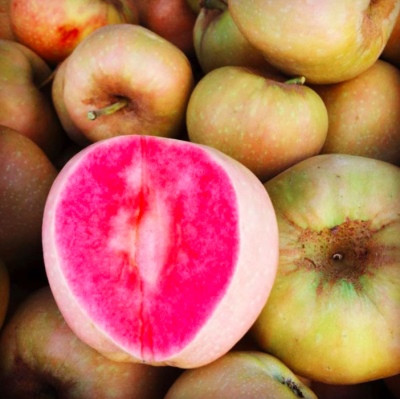
- Authors: Northern California, by Albert Etter
- Taste: sweet, tart, with hints of raspberry and grapefruit
- Scent: pronounced
- Fruit weight, g: 150–200
- Fruit size: average
- Yield: 30-50 kg per tree
- Frequency of fruiting: periodic
- The beginning of fruiting varieties: for 2 years
- Ripening terms: late summer
- Removable maturity: from the second half of August to mid-September
Pink pearls are an apple variety bred in Northern California by Albert Etter. During the selection, the Surprise variety was used, which served as a grafting material. In Russia, the presented variety is gaining more and more popularity.
Description of the variety
This is a fast-growing variety that belongs to natural semi-dwarf trees. Plant height - 4.5 m. Beautiful flowers of bright pink color attract special attention.
Features, pros and cons
Among the features of the presented variety, the following advantages should be noted:
- the tree is characterized by high winter hardiness and picky care;
- fruits are famous for their aesthetic appearance and good taste, and their purpose is universal;
- apples of this variety contain a large amount of vitamin C, iron, fiber.
The disadvantages include the short shelf life of the fruit - only 4 weeks, as well as poor resistance to scab. In addition, this is a self-infertile variety, so you need to use pollinators, that is, varieties with the same ripening period.
Ripening and fruiting
The presented variety belongs to varieties with late summer ripening period. Removable maturity begins in the second half of August and lasts until mid-September. Fruiting is periodic, and the first fruits can be enjoyed already in the second year after planting the culture.
Yield
It is possible to harvest an average of 30-50 kg of apples from one tree.
Fruits and their taste
The apples are medium in size, their weight is 150-200 g. The color is yellow-green or plum, the skin is translucent, tiny white subcutaneous dots are noticeable. The pulp of the fruit is bright red or pink with a pearlescent hue, juicy, crunchy, and has a pronounced aroma. The fruit tastes sweet, tart, with raspberry or grapefruit notes.

Growing features
Particular attention should be paid to the apple tree at the planting stage. Planting is carried out in early spring, when the soil has already warmed up, or in the fall, a month before frost. Observe the following rules:
- choose a sunny and wind-protected area for planting with groundwater at least 2 m;
- dig a hole with a diameter twice the size of a clod of earth on the seedling;
- mix the fertile soil layer with humus or peat, add potassium superphosphate and wood ash, mix and fill the hole with the resulting composition by a third;
- insert a stake in the middle, later a tree will be tied to it;
- straighten the roots of the seedling, plant it in a hole, cover the remaining space with soil and compact the planting site;
- make sure that the root collar is 5-6 cm above the ground;
- water the area with 2-3 buckets of water and add a layer of mulch, for example, peat or sawdust;
- for group planting, keep a distance of 3.5-4 m between seedlings.
Experienced gardeners give the following recommendations for the care of the Pink Pearl variety.
- Young trees need to be watered more often, 2-3 times a month. With age, watering can be reduced or stopped altogether, depending on the climate.
- Formative pruning provides for limiting growth to 4 m with a stem height of 60-70 cm. The crown is formed from 5-6 skeletal branches of the first order until the tree is 5-7 years old.
- In the spring and fall, it is important to carry out sanitary pruning, which includes the removal of dry and damaged branches.



Top dressing
In the first year, the culture does not need to be fertilized, the tree has enough nutrients laid down at the planting stage. Further, the variety needs several dressings per season.
- In the spring, in April, nitrogen mixtures are recommended. Among organics, mullein and bird droppings are more popular; urea is suitable from minerals. During this period, fertilizers are applied around the tree in the trunk circle.
- In the flowering phase, solutions such as slurry or urea are relevant.
- After harvesting, the plant must be prepared for winter, for this it is fed with a mixture of superphosphate and potassium sulfate.

Frost resistance
The apple tree of this variety is highly winter-hardy, but if the tree is grown in the northern regions, then you need to help it survive the harsh time. To do this, use a few tips:
- apply a layer of mulch, such as peat or sawdust, and cover with earth on top;
- wrap the tree with spruce branches or fabric material to a level of 1.5 m;
- tie the trunk and any large branches to the support.

Diseases and pests
The presented variety cannot boast of good immunity to diseases and insects, so it needs to be protected from these ailments. As a preventive measure, spring spraying is used. When there is already a lesion, you need to turn to the help of insecticides and fungicides, but it is allowed to process the crop with them before the fruits ripen.
The main enemy of the apple tree is scab. To strengthen the health of the tree and increase its resistance to this disease, it is recommended to use biostimulants.

The apple tree is a popular fruit crop among gardeners. It can be found in many summer cottages. But at the same time, such trees are often affected by various diseases. It is very important to recognize the disease in time and carry out the necessary procedures for a speedy recovery. Otherwise, the fruits will be spoiled, and the tree itself may die altogether.












































































